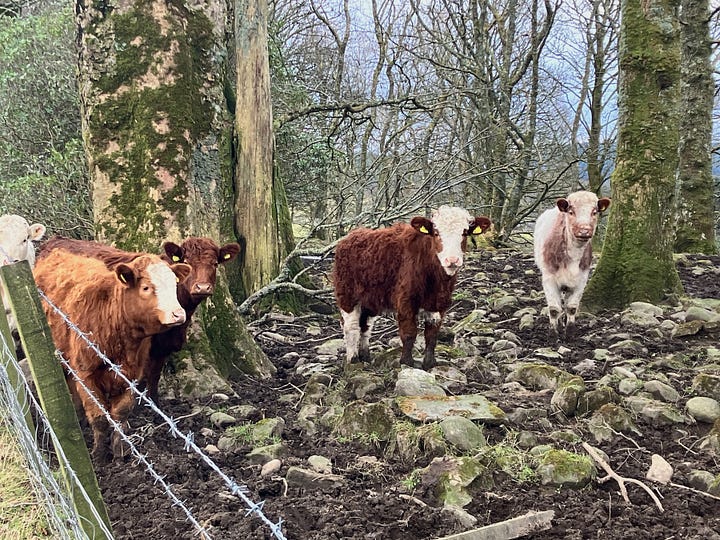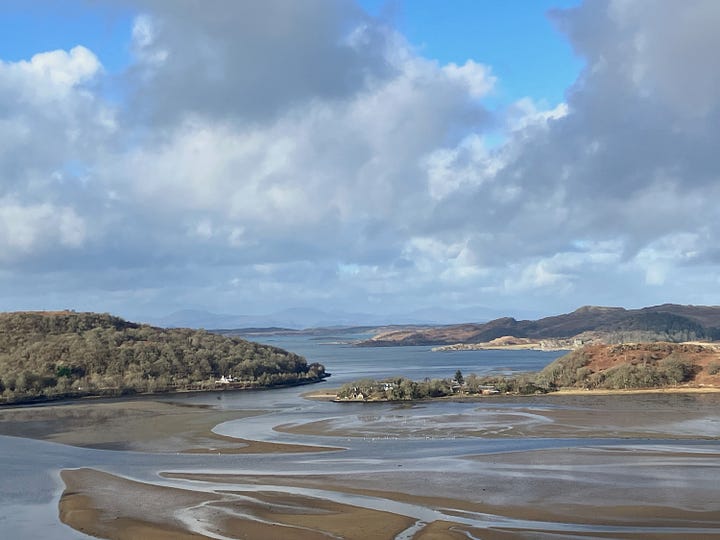We’re staying in Tayvallich, Scotland for three weeks, the longest we’ve stayed anywhere in the past six months. Long enough for the unfamiliar to become familiar. To know that around that bend in the road will be four black sheep holding a little meeting by the lake. To know what time the birds like to tweet up a storm. To know when the little mossy seal statue on the rocky harbor beach will disappear under the tide.
I spend a lot of time just looking out the living room window to the harbor across the street. It’s filled with sailing boats and the tiniest little fishing boats you’ve ever seen. A big red and white boat is the greatest source of excitement. It’s some sort of working boat — it goes out during the week and sometimes comes to the dock to unload before going back out to its mooring ball. But we still aren’t exactly sure what it does.
The harbor we’re on is Loch a’ Bhealaich, a sheltered little offshoot of Loch Sween, which runs for another six miles or so out to sea. It’s presumably saltwater, though one morning we woke up and the harbor had iced over — an unexpected development since it’s rarely been below freezing here. The gentle waves and sun took care of the ice quickly enough.
Despite the lack of activity (with the exception of the red boat), the harbor is always changing. Sometimes the water is glass-smooth, perfectly reflecting all the little boats. Other times, the wind whips across the water, sending the mooring balls and boats bobbing. As the sun sets behind the hills, the boats become luminous, their white hulls somehow glowing with the dying light against the darkening water.
But I manage to tear myself away from the harbor most days and head out to explore the area - one of the long fingers of land in western Scotland. It has a wonderfully diverse landscape - sea lochs and freshwater lochs and a thousand little streams and rivers and waterfalls. Rocky beaches and bogs and salt marshes and mudflats. Woodlands - both farmed and ancient - and craggy hills and fields. And plenty of interesting human-made things too, like the Crinan Canal and ancient stone circles and cairns and lighthouses. The animals are a bit different than other parts of Scotland we’ve been in - a greater variety of cows, Shetland ponies, black sheep, and white-bodied sheep with black faces and little black and white patterns on their legs - it looks as if the sheep are wearing chic leggings under white fluffy coats.


I’ve been particularly entranced by the bog I saw while walking along the Crinan Canal — they call it Moine Mhor or “the Great Moss.” During the winter, its colors and activity are muted, its grasses reminding me of the golden California hills in the fall. Warmer weather brings vibrant colors, strange plant life, like the carnivorous sundew, and rare dragonflies and butterflies.
The Great Moss is a particularly precious and important bog because it’s a relatively well-preserved and quite rare lowland raised peat bog (this manifests as a little raised mound in the middle of it). As I’ve learned in my time in the UK, especially in Scotland where there are a lot of them, peat bogs are miraculous things.
Though they cover just three percent of land on earth, peat bogs store more carbon than all the forest on earth combined. A big reason for this is that dead things don’t degrade in a bog (remember bog people?); instead, the dead plants become peat. This makes them incredible carbon sinks, but also create huge problems if destroyed — all that stored carbon gets released. Something like 80% of the peat bogs in the UK are degraded - by agricultural “improvement”, drainage, or grouse hunting (which I wrote a bit about here). As with so much right now, peat bogs in the UK are at a tipping point.
I think some find peat bogs to be quite bleak, but I find them beautiful (though to be fair, I’m here at the non-buggy time of year). But I am a bit scared of them - there are so many warnings about watching where you step and that you might fall into a bog hole. It gives me the same little thrill of fear that quicksand did as a kid.
So I mostly stay out of the muck, sticking to roads and farm tracks and only venturing out on to the bog if there’s a sturdy wooden boardwalk. And there’s still a lot to see and hear. All of these squishy squelchy places around here - the bogs and mudflats and salt marshes - teem with life, even in the dead of winter. Liminal, shaggy places that maintain and create the biodiversity that the UK so desperately needs (the UK is one of the most “nature-depleted” places in the world). I’ve been reading a lot of books lately by farmers in the UK who want to do things differently - to bring wildness back to their land while still making food for people. Who want to give to the earth and not just take from it. And a common theme is that the best thing we can do for nature is let it be “untidy” - it’s the lack of uniformity and monoculture and straight lines that allows it to thrive.
I’ve been doing this unintentionally in my own tiny backyard in San Francisco. A policy of benign neglect — though this doesn’t mean I ignore it. Quite the opposite - I spend many hours looking out at it (notice a theme here??). But I let it run free. I don’t rake the leaves or use pesticides or fertilizer. I used to let the vines and bushes grow any which way they pleased, before I was very gently asked by a neighbor to trim them so they wouldn’t get hit in the face by foliage every time they went in the backdoor of our apartment building. Besides pruning and the occasional watering, I let my backyard do its thing for which I’ve been rewarded with hummingbirds and songbirds and little field mice and boatloads of flowers that I can leave in little jam jar offerings for my neighbors (the least I can do).
I think enjoying my back yard and watching it change through the seasons (yes California does have seasons) and knowing when the pinks and the yellows and the reds and maroons and purples will bloom (I still don’t know the name of any of the plants there) has, in some strange way, prepared me for this trip. To really notice the different grasses and lichens and mosses. To sit contentedly at the window and watch the water in the harbor reflect the sky.







Got to make it to your little garden some day. Another great piece. When you get home get the Seek app by inaturalist for identifying plants and animals
Gorgeous pictures and vivid descriptions- very glad you have steered clear of the bog holes!